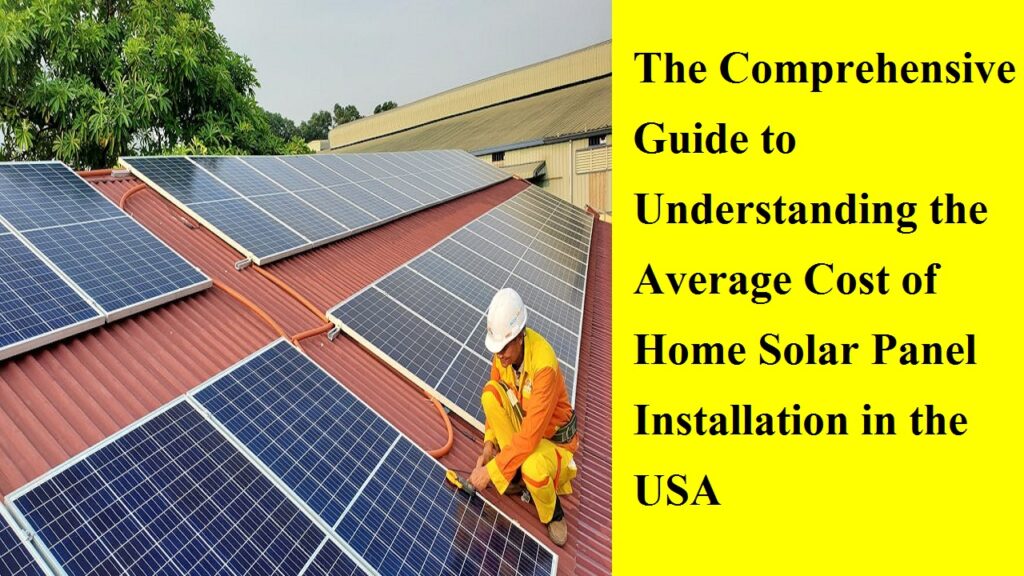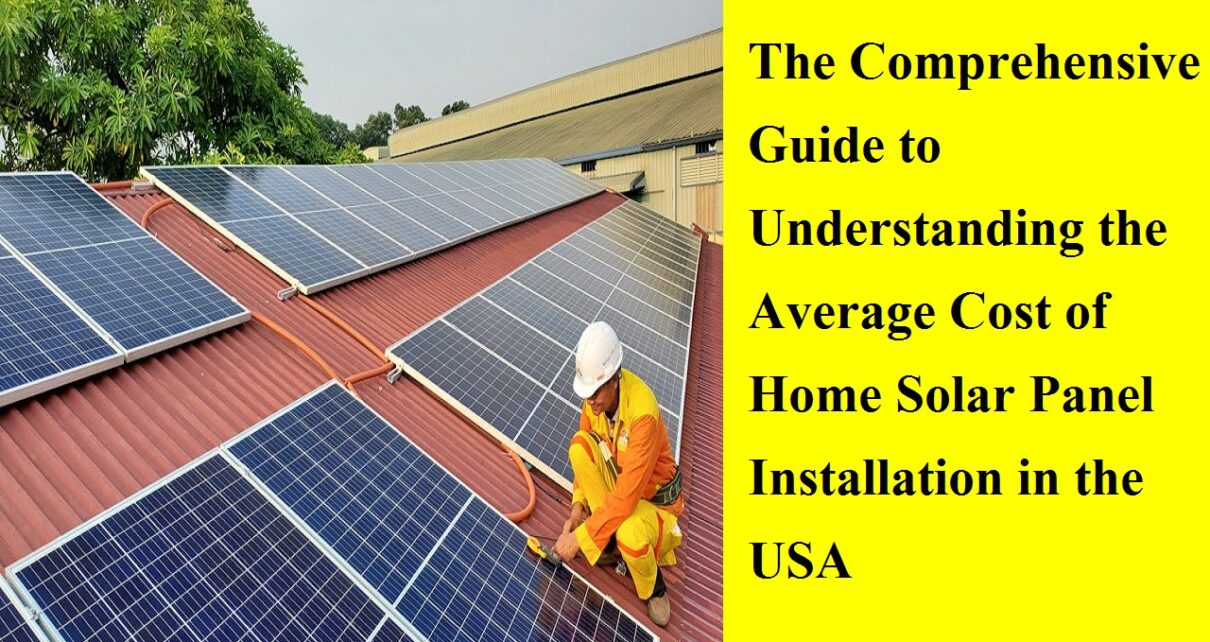
Average Cost of Home Solar Panel Installation in the USA : In the face of rising energy costs and a growing concern for environmental impact, solar energy has emerged as a compelling alternative for American homeowners. Harnessing the power of the sun to generate electricity not only reduces dependence on traditional energy sources but also fosters a more sustainable future. However, navigating the initial investment required for home solar panel installation can be a challenge. This comprehensive guide dives deep into the intricacies of solar panel installation costs in the USA, empowering you to make informed decisions for your clean energy journey.
Average Cost of Home Solar Panel Installation in the USA
Factors Influencing Solar Panel Installation Costs:
Understanding the variables that influence solar panel installation costs is crucial for budgeting and cost optimization. Here are some key factors to consider:
Location:
Sunlight availability varies drastically across the United States. States with abundant sunshine hours, like Arizona and California, typically require smaller systems to achieve desired energy output, leading to potentially lower installation costs. Additionally, local permitting processes and regulations can impact the overall price tag.
System Size:
The size of your solar panel system, measured in kilowatts (kW), directly correlates to upfront costs. Larger systems with higher wattage capacity generate more electricity but require more panels and installation labor, leading to a higher initial investment. However, these systems can significantly reduce your reliance on the grid and translate into greater long-term savings on energy bills.
Type of Panels:
Solar panels come in various types, each with its own efficiency and cost point. Monocrystalline panels boast the highest efficiency, converting sunlight into electricity most effectively, but are typically the most expensive option. Polycrystalline panels offer a balance between efficiency and affordability, while thin-film panels are the most budget-friendly but have lower efficiency ratings. Consider your budget alongside your energy needs and sunlight conditions when selecting the type of panel.
Roof Condition:
The state of your roof significantly impacts installation costs. Factors like roof pitch (angle), shading from trees or structures, and the underlying roof material (composition shingles, metal roofing) can influence the complexity of the installation process. Roofs requiring additional work, such as reinforcement or modification for optimal panel placement, may incur higher costs.
Incentives and Rebates:
Fortunately, numerous federal, state, and local incentives and rebates can significantly offset the upfront cost of solar panel installation. The most prominent federal incentive is the Investment Tax Credit (ITC), which currently offers a 26% tax credit on solar installation costs through 2022 (subject to change). Additionally, many states and local municipalities offer generous rebates and financing programs specifically for renewable energy projects. Carefully researching available incentives in your area can substantially reduce your out-of-pocket expenses.
Average Cost Breakdown:
While a definitive national average cost for solar panel installation can be elusive due to the factors mentioned above, industry data provides a helpful starting point:
National Range:
The nationwide average cost for a typical 5 kW solar panel system installation falls between $10,000 and $25,000 before factoring in federal and local incentives.
State Variations:
Location plays a significant role in installation costs. States like California and New York tend to have higher average costs due to factors like higher demand for solar installations, stricter regulations, and a generally higher cost of living. Conversely, states with abundant sunshine and robust incentive programs, such as Arizona and Texas, may offer more competitive installation costs.
Incentives Impact:
Thankfully, the aforementioned federal ITC and state/local incentives can significantly reduce the net cost of solar panel installation. The 26% federal ITC alone can translate to substantial savings, making solar power a more attainable investment for many homeowners.
Tips for Cost-Effective Solar Panel Installation:
Now that you understand the various factors affecting solar panel installation costs, here are some key strategies to ensure you get the best value for your investment:
Compare Multiple Quotes:
Don’t settle for the first quote you receive. Obtain proposals from several reputable solar installers in your area. Carefully compare pricing structures, warranties offered, equipment quality, and customer service reputation before making a final decision.
Consider Long-Term Savings:
While the initial investment for solar panels may seem substantial, it’s crucial to factor in the long-term financial benefits. Solar panels significantly reduce your reliance on the grid, leading to substantial savings on electricity bills over their lifespan (typically 25-30 years). Consider utilizing online tools or consulting with solar installers to estimate your potential energy cost savings based on your historical energy usage and chosen system size.
Explore Financing Options:
Many solar companies offer various financing options, such as solar loans and leases, to make solar panel installation more accessible for homeowners who may not have the upfront capital required. Explore these options and choose the one that best suits your financial situation.
Research Incentives :
Don’t underestimate the power of researching available incentives. Federal and state websites often provide comprehensive information on current solar programs and rebates. Additionally, local municipalities and utility companies may offer their own incentive programs specifically for residents within their jurisdiction. Taking advantage of all available incentives can significantly lower the upfront cost of your solar panel installation.
Roof Assessment:
Schedule a free roof assessment with a qualified solar installer. This assessment helps identify potential challenges or considerations specific to your roof that might impact installation costs. A professional assessment can also ensure your roof is structurally sound and suitable for supporting solar panels.
Understand Warranties:
Solar panel systems typically come with multiple warranties covering aspects like performance, workmanship, and product defects. Carefully review and understand the terms of these warranties offered by different installers and manufacturers. A strong warranty provides peace of mind and protects your investment in case of unexpected issues.
Beware of Upselling:
While some features may enhance your solar panel system’s functionality, be cautious of unnecessary upsells. Reputable installers will present options that align with your specific needs and budget. Do your research on additional features and prioritize those that demonstrably improve system performance or offer long-term value.
Harnessing the Power of Solar:
By understanding the factors influencing solar panel installation costs and implementing these cost-saving strategies, you can make an informed decision about integrating solar energy into your home. Investing in solar power not only benefits the environment by reducing your carbon footprint but also offers significant financial advantages over the long term. With the increasing popularity of solar energy and ongoing advancements in technology, solar panel installation costs are expected to continue decreasing, making renewable energy a more accessible option for homeowners across the USA.
Additional Considerations:
This guide serves as a comprehensive starting point for understanding solar panel installation costs. Here are some additional factors to consider as you delve deeper into your solar energy journey:
Battery Storage:
While not always necessary, solar battery storage allows you to store excess solar energy generated during the day for use at night or during peak electricity usage times. Battery storage can increase your overall system cost but offers greater energy independence from the grid.
Homeowner’s Association (HOA) Regulations:
If you live in a community governed by an HOA, ensure you comply with any regulations regarding solar panel installation. HOAs may have specific guidelines regarding aesthetics, placement, or visibility of solar panels.
Solar Panel Maintenance:
Solar panels require minimal maintenance, typically consisting of periodic cleaning to ensure optimal performance. Factor in potential cleaning costs when evaluating long-term expenses.
By carefully considering these factors and leveraging the valuable information provided in this guide, you can embark on a rewarding journey towards a sustainable and cost-effective solar-powered future for your home.
- Unleash the Harvest: Fast-Growing Vegetables for California’s Raised Garden Beds
 Fast-Growing Vegetables for California’s Raised Garden Beds : California’s golden sunshine, mild climate, and fertile soil are a gardener’s dream. Elevated planting in raised garden beds takes this advantage to the next level. These controlled environments offer improved drainage, easier pest management, and the perfect canvas for cultivating a fast and furious vegetable bounty. Fast-Growing… Read more: Unleash the Harvest: Fast-Growing Vegetables for California’s Raised Garden Beds
Fast-Growing Vegetables for California’s Raised Garden Beds : California’s golden sunshine, mild climate, and fertile soil are a gardener’s dream. Elevated planting in raised garden beds takes this advantage to the next level. These controlled environments offer improved drainage, easier pest management, and the perfect canvas for cultivating a fast and furious vegetable bounty. Fast-Growing… Read more: Unleash the Harvest: Fast-Growing Vegetables for California’s Raised Garden Beds - Pitbull Announces Party After Dark Tour With T-Pain: A Must-See Event for Music Lovers
 Pitbull Announces Party After Dark Tour With T-Pain : Pitbull, the renowned artist known for his electrifying performances and chart-topping hits, has recently announced the much-anticipated “Party After Dark Tour” featuring none other than the iconic T-Pain as a special guest. This tour promises to be a spectacular celebration of music, bringing together two powerhouse… Read more: Pitbull Announces Party After Dark Tour With T-Pain: A Must-See Event for Music Lovers
Pitbull Announces Party After Dark Tour With T-Pain : Pitbull, the renowned artist known for his electrifying performances and chart-topping hits, has recently announced the much-anticipated “Party After Dark Tour” featuring none other than the iconic T-Pain as a special guest. This tour promises to be a spectacular celebration of music, bringing together two powerhouse… Read more: Pitbull Announces Party After Dark Tour With T-Pain: A Must-See Event for Music Lovers - Unwind with Your Furry Friend: Pet-Friendly Cabins with Private Hot Tubs near Yellowstone National Park
 Pet-Friendly Cabins with Private Hot Tubs near Yellowstone National Park : Yellowstone National Park, a crown jewel of the American wilderness, beckons adventurers with its geysers, hot springs, and breathtaking landscapes. But what if you could experience this wonder alongside your furry best friend? Imagine returning from a day of exploring the park’s marvels, sharing… Read more: Unwind with Your Furry Friend: Pet-Friendly Cabins with Private Hot Tubs near Yellowstone National Park
Pet-Friendly Cabins with Private Hot Tubs near Yellowstone National Park : Yellowstone National Park, a crown jewel of the American wilderness, beckons adventurers with its geysers, hot springs, and breathtaking landscapes. But what if you could experience this wonder alongside your furry best friend? Imagine returning from a day of exploring the park’s marvels, sharing… Read more: Unwind with Your Furry Friend: Pet-Friendly Cabins with Private Hot Tubs near Yellowstone National Park - Cultivate Your Dreams: Building a Raised Garden Bed in Tight Spaces
 Building a Raised Garden Bed in Tight Spaces : For city dwellers and space-conscious gardeners, the dream of fresh, homegrown produce might seem like a distant utopia. But fret no more! Raised garden beds offer a game-changing solution, transforming even the most limited balconies, patios, or sunny nooks into flourishing mini-farms. Building a Raised Garden… Read more: Cultivate Your Dreams: Building a Raised Garden Bed in Tight Spaces
Building a Raised Garden Bed in Tight Spaces : For city dwellers and space-conscious gardeners, the dream of fresh, homegrown produce might seem like a distant utopia. But fret no more! Raised garden beds offer a game-changing solution, transforming even the most limited balconies, patios, or sunny nooks into flourishing mini-farms. Building a Raised Garden… Read more: Cultivate Your Dreams: Building a Raised Garden Bed in Tight Spaces - Best Organic Mattresses for Back Pain Sufferers Under $1,500
 Best Organic Mattresses for Back Pain Sufferers Under $1,500 : Waking up with a crick in your neck or lower back pain can put a damper on anyone’s day. But for chronic back pain sufferers, a good night’s sleep can feel like a distant dream. The right mattress can make a world of difference, providing… Read more: Best Organic Mattresses for Back Pain Sufferers Under $1,500
Best Organic Mattresses for Back Pain Sufferers Under $1,500 : Waking up with a crick in your neck or lower back pain can put a damper on anyone’s day. But for chronic back pain sufferers, a good night’s sleep can feel like a distant dream. The right mattress can make a world of difference, providing… Read more: Best Organic Mattresses for Back Pain Sufferers Under $1,500




